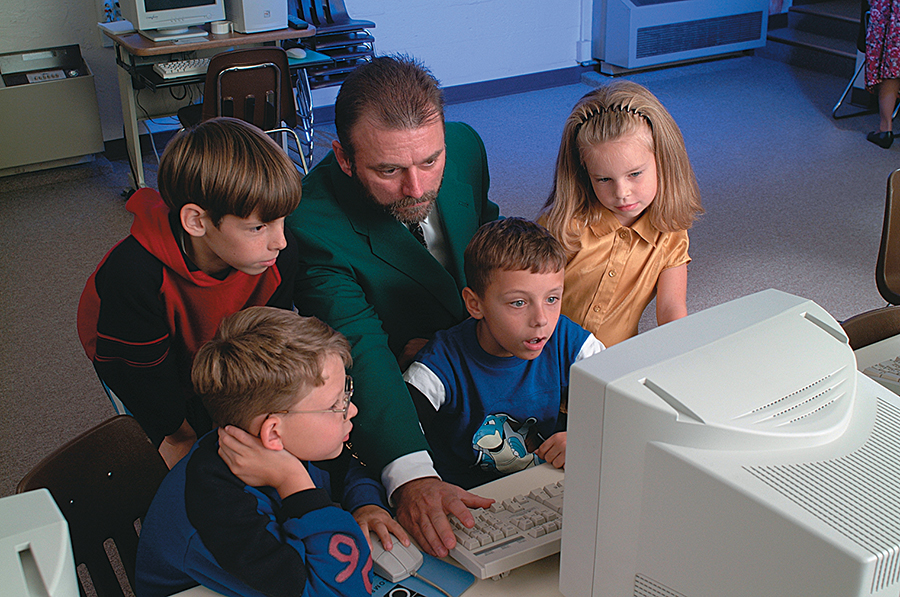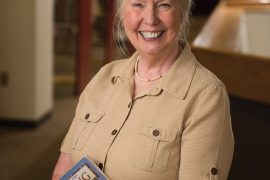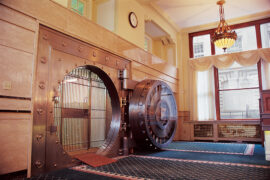The Little School that Could
By Dan O’Hanlon
HQ 40 | AUTUMN 2000
Imagine this: as a reward for completing an after-school tutoring program, a class of elementary school children were given a ‘free hour’ in the school’s brand new computer lab. After 50 minutes, the teacher announces that the students can now stop working on the computers and have some ice cream before heading to their next class.
No one moves … the teacher again tells them to go get their ice cream. Finally one student pipes up, “Do we have to? I’d rather stay at my computer a few more minutes.” The teacher agrees that anyone who wants to stay instead of eating ice cream is free to do so. Not one child leaves … not one child!
This is what routinely happens in the computer lab at Kellogg Elementary School in the Westmoreland section of Huntington. And, perhaps even more amazing, the lab was built completely from private donations. Here’s how it happened.
In early 1999, Angie Buck happened to mention to her grandfather, Huntington businessman Robert Shell, Jr., that she sure enjoyed using the computer at school, but wished she didn’t have to wait so long to use it since there was only one for the whole class. Mr. Shell checked into this and discovered that, while there was a plan to put state of the art computer labs in every school in Wayne County, the high schools were being done first, then the middle schools, and finally the elementary schools. He realized that his granddaughter would probably have graduated by the time Kellogg got its new lab.
If there’s one thing you can say about Robert Shell, it’s that he’s a doer, not a talker. He immediately asked whether there was any rule or regulation prohibiting the school from building the lab with private funding. Discovering there was none, he began organizing parents, teachers and local volunteers to get the job done as quickly as possible.
The Wayne County School Board, and especially its chairman, Tommy Gibson, gave the project all the help and support it needed inside the system. Roger Perry drew on his experience building labs at the high schools to help design a terrific elementary school facility. EZNET donated high-speed internet access and co-founder Arlen Keane volunteered to train the teachers. Hourly Computer did the initial installation and maintenance of the computers. Parents like Jackie McMullen, Karen Rucker and Cheryl Bledsoe got the PTO involved in raising money for additional software. Principal Brenda Francis and teachers like Carolyn Lane spent an unbelievable amount of time getting things ready at the school. Even the kids got involved and donated over $300 they raised themselves.
All the while, from behind the scenes, Robert Shell raised funds from Ferris Baker Watts and others, chaired meetings and kept all eyes focused on the goal — giving kids in this community (where computers in the home are rare) access to the best computer technology before, during and after school.
School Superintendent Wilt Salmons said that because the project was privately funded, it cut through a lot of the red tape that slows down any state or federal project. As a result, less than four months after the idea was conceived, Kellogg School had a lab full of excited children glued to their computer screens, turning down ice cream. A $200,000 dream had been realized in record time.
On May 24, 1999, Governor and Mrs. Cecil Underwood were joined by Mayor Jean Dean and State Sen. Bob Plymale to dedicate the new elementary school lab in Wayne County. Calling it a “model of cooperation,” the Governor said, “This is an investment in the future and I am very excited that students will be able to learn using this tool.”
Robert Shell told the crowd of proud parents, teachers and students, “It’s time to stop waiting on all the help from government. It’s our duty to prepare our children for the 21st Century.”
Arlen Keane, who taught programmers at Microsoft before coming to Huntington, says that a computer lab is like adding Miracle-Gro to a child’s educational experience.
“Their ability to use the internet to do research now comes as easily to them as using a dictionary or an encyclopedia. Knowing how to use a computer program, or how to make and use computer files, will serve them well all their lives and prepare them for future jobs.”
The computer learning tools allow each child to learn at his or her own pace, without the embarrassment of having their skill level constantly compared with other students. Using the new Accelerated Reader program let Shane, a fourth grader, improve his reading level 1.6 years in just four months.
Hannah, a second grader, and Sarah, a third grader, improved their reading 2.4 years in the same period. In fact, the entire school significantly improved their overall scores on the SAT9 after less than a year of using the new lab.
And it’s not just the students who are learning. Teachers at the school who were once a bit intimidated by computers are now its most enthusiastic supporters. Ruth Spangler, who teaches fourth grade, says, “The computer lab has opened the world of technology to the students, staff and parents of the Westmoreland area. The lab has inspired me to learn new ideas to share with my students. Mr. Shell, in donating funds for the installation of the lab, has touched many lives and inspired not only children, but adults to move forward in the technology area.”
The lab is now run by network professional James Adkins, whose salary is donated by a local company. His idea of starting an after school computer club had such a huge response, he had to break it into four different sections. He also allowed the lab to stay open in the summer after school had ended. Students came day after day on their own to continue using the reading and math programs, as well as other computer resources available in the lab. Many of them have learned to create their own homepages. Third grader Alyssa says, “I like going to the computer lab because when I’m having fun I’m also learning. So I think the computer lab is a great idea.”
Menis Ketchum, a Kellogg graduate who generously contributed both time and money to help make this all a reality, likes to tell a story about when he was a rambunctious first grader at the school. “We had an eighth grader who was a patrolboy and he was pretty strict. It seems like he was always making me stand in the ‘penalty box.’” The patrolboy’s name was Marshall Reynolds. And it was in honor of that same eighth grader that Robert Shell insisted the lab be named. No one was more surprised than Reynolds when the name of the lab was announced at the dedication.
“I’m pleased with the gesture,” he said, “but this project is a credit to Bob Shell. I can remember when this school was very different. I think this computer lab is great for the kids.”
On October 23, 2000, the City of Huntington honored Reynolds, Shell and all of those involved in making this incredible computer lab a reality for the children of Westmoreland. The City recognized that, since the computer lab has opened, contributions have allowed the entire school to upgrade its security cameras and alarms. Additionally, the school has been able to upgrade all the existing classroom computers and connect them into the lab, so students can access the programs from their classrooms. This more than doubled the number of computers from 28 to over 60.
Building the lab has taught the parents and teachers at Kellogg to dream big dreams. They are currently planning to raise more money to buy laptop computers for kids to ‘check out’ like library books and take home evenings and weekends. They would like to add an additional networked computer to each classroom. And they would like to partner with Marshall University to become the first elementary school to have videoconferencing capabilities in the lab. This would allow them to have distance learning capabilities and perhaps allow student teachers at Marshall’s College of Education to do part of their student teaching at the Kellogg ‘Lab School’ by computer.
The story of the ‘little school that could’ ends much differently from the way it began. Angie no longer has to wait in line to use the computer. Kids are learning faster than ever at Kellogg. Parents and teachers have learned that a community can take control of its own destiny and create the future their children want and need.
And the kids? Well, they asked me to be sure and invite you to stop by and see their new lab anytime, day or night. What’s that you say? No, parking won’t be a problem, because you’ll fly through space and visit them at www.kelloggschool.com.





